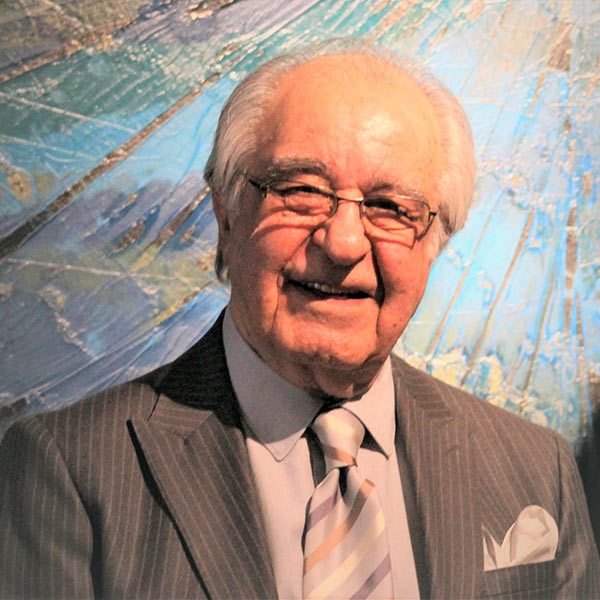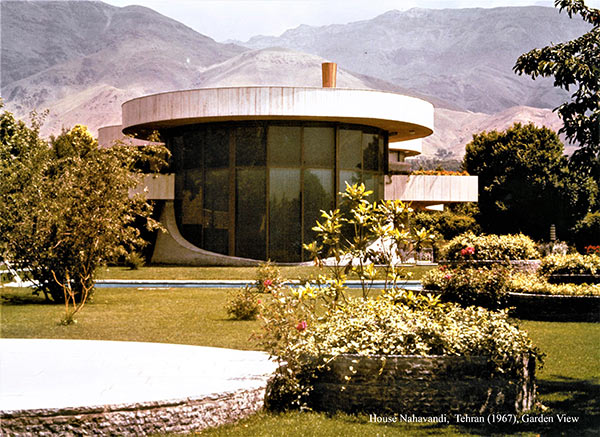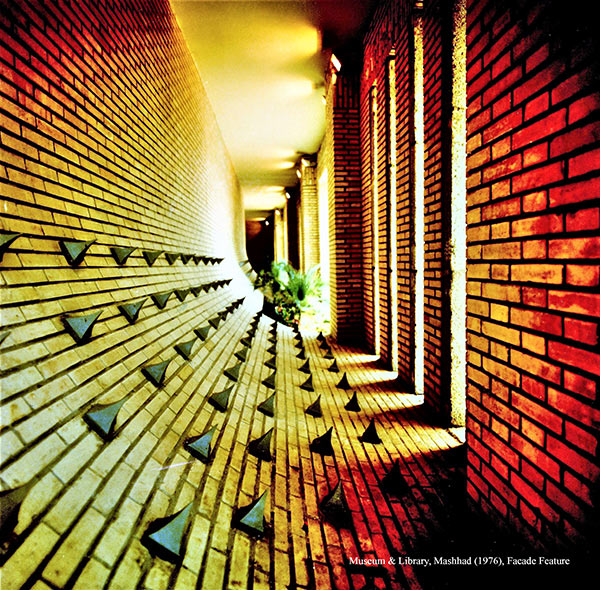
Dariush Borbor. Presentation of 2000 Solar Heated Apartments Neighbourhood, Mashhad, Iran, 1977 (Own work, CC BY-SA 4.0)
As a professional: he is widely regarded as one of the most avant-garde architects of the second half of the 20th century modern movement who deviated from the traditional ‘cubic’ architectural forms and introduced ‘open’, ‘fluid’ and ‘non-rectilinear’ spaces and lines in his work. He is also considered as a pioneer of modern urban planning in Iran.

House Nahavandi by Dariush Borbor, Tehran (1967), Garden View
As an iranologist: Borbor created the Research Institute and Library of Iranian Studies in 1992, an independent, private, non-profit institution dedicated to research on the Middle East and in Iranian and Persianate studies with special emphasis on novel and creative research. Some of the pioneering studies of which include: a comprehensive ethnographic study of the Borbor tribe; an Analytical, Comparative, Etymological Linguistic Study of Reduplication in the Major Languages of the Middle East and Iran; a Central Alborz Southern Piedmont Ethno-Linguistic Study; and a Catalogue of Wine and Wine Equipment in the Ancient World, all of which include various publications or are due for publication. In 2015, he founded the Borbor Series of Seminars, involving the scholarly exchange between eminent scholars residing outside of Iran, and vice versa to discuss, exchange and propagate research and knowledge.

Museum & Library by Dariush Borbor, Mashhad (1976), Facade Feature
As an academic: he has lectured extensively on architecture, urban planning, history, ethnography, cognitives, etymology and linguistics in many notable and distinguished academic institutions and universities around the world, including: the Austrian and Russian Academies of Sciences; universities of Cambridge, London, St Andrews, Bern, Jagiellonian, Marburg, Munster, Heidelberg, Freie Universität, Louvain, Ohio, UCLA, Toronto, Lahore, Yerevan, Istanbul, Sharif and Tehran.
As an author and researcher: over a hundred papers in scholarly journals, some of which are translated and published in various languages, including several encyclopaedias such as the Encyclopedia of Urban Planning, Encylopædia Iranica, and the Great Islamic Encyclopedia. Monographs include: Majlis: Teheran, Iran, University of Liverpool, Google Books, Liverpool, 1958; D. Bourbour [Borbor], Projet de Rénovation de Haram Hazrat-e-Reza à Meched, Tehran, 1972; Dariush Borbor Compendium of Articles, Presentations and Interviews 1954-2018, Tehran, 2018; and the Analytical, Comparative, Etymological Dictionary of Reduplication in the Major Languages of the Middle East and Iran; Arabic, Armenian, Kurdish, Persian and Turkish, due for publication 2022.
As a visionary: Borbor proposed a comprehensive application of solar energy (1964), and mass produced, prefabricated schools (1965) for Iran; he also proposed the founding of the Iranian National Urban Planning Authority (1966), and the establishment of a Comprehensive National Environmental Master plan for Iran (1976).
Prizes and Distinctions include: Gold Mercury International, Italy, 1975; 50 Outstanding Architects of the World, Belgrade Triennial of World Architecture, 1988; Knight of the Order of Arts and Letters, France, 2020; EduRank 100 Notable Alumni, University of Liverpool, 2021.
Borbor is extensively consulted and interviewed by the academia and the international media.
Further Reading
Dariush Borbor, Dariush Borbor Compendium of Articles, Presentations and Interviews 1954-2018, Sahab Geographic & Drafting Institute, Tehran, 2018.
Back to: School of Architecture